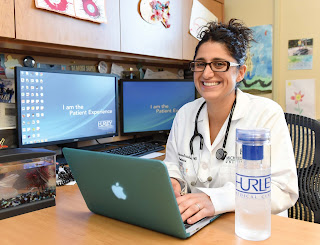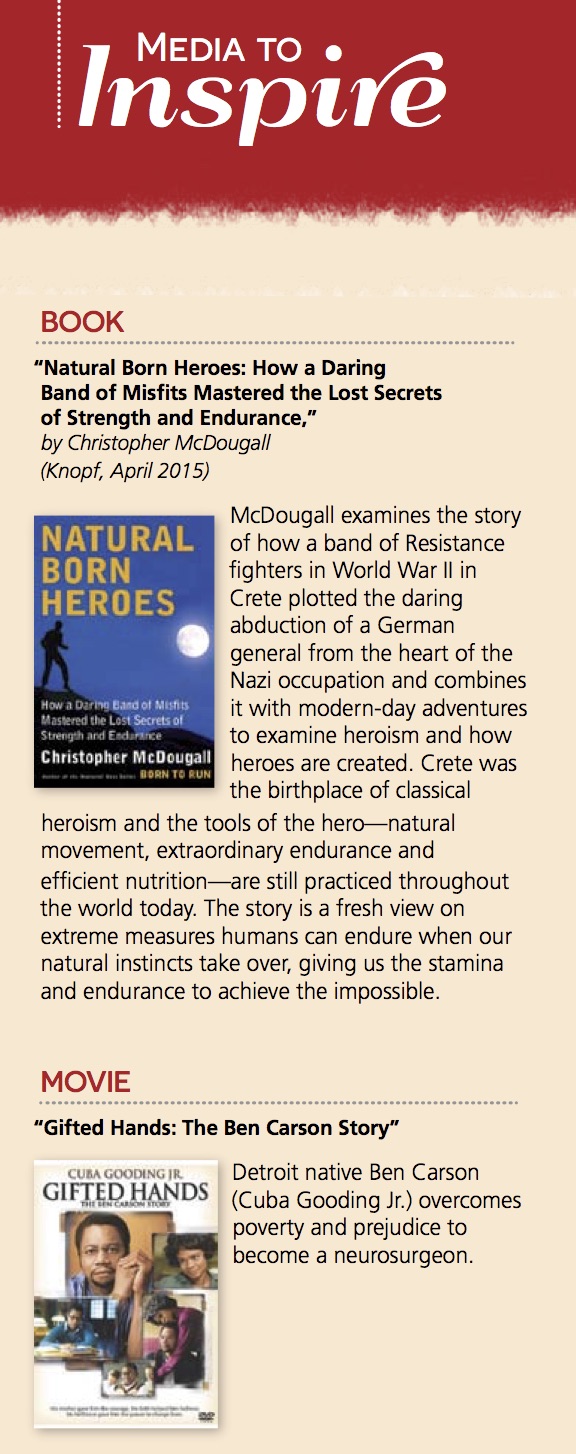Dr. Mona Hanna-Attisha: Hero for Flint

B By Brooke Lamson
In the past five months, Dr. Mona Hanna Attisha has been interviewed by Rolling Stone, Rachel Maddow and media outlets from as far away as England and India. She testified before an Environmental Protection Agency clean water committee in Washington D.C., and participated in on a Huffington Post panel with famed environmental activist Erin ‘Brockovich.
It’s been a bit overwhelming, but one moment stands out for Hanna-Attisha, Director of the Pediatric Residency Program at Hurley Children’s Hospital
and a Michigan State University professor, who gained the international spotlight for her study that revealed the percentage of Flint children with elevated levels of lead in their blood doubled after the city of Flint switched its municipal water source to the Flint River to save money.
It came when a small boy, a second-grade classmate of her daughter, approached her after a talk she gave at the school.
 “You’re Layla’s mom. My mom read us the story about how Layla’s mom saved the city from being poisoned,” he told her.
“You’re Layla’s mom. My mom read us the story about how Layla’s mom saved the city from being poisoned,” he told her.
A Hero for Flint
Hanna-Attisha was the right person when Flint needed her most. No wonder a Flint pastor told attendees at an ACLU banquet last year
“God sent us Dr. Mona.” MSNBC anchor Rachel Maddow echoed that sentiment when she introduced Hanna-Attisha in her December broadcast: “If you are looking for a hero in this story, she is a hero.”
The 39-year-old pediatrician’s background, interests, training and passion — not to mention the unlikely coincidence of having a high school friend who is a former federal water quality expert — all
combined to uncover the impending Flint water health catastrophe.
“Everything in my life prepared me for this,” Hanna-Attisha said. “I just needed the strength and the courage to not ignore it.”
Advocating for Children
She looks back to her teens in suburban Detroit, when her environmental activism was sparked by campaigning to shut down a trash incinerator in Madison Heights that spewed toxins into the air.
In addition to her medical training and focus on children, especially poor children, she also holds a master’s degree in public health, giving her the skills to undertake the blood test analysis.
And advocacy has alway been a crucial part of a doctor’s role, she believes. Even before the water crisis, she urged the doctors and medical students she supervises at Hurley Medical Center to not just treat children, but to advocate for them as well.
“Remember why you became a pediatrician,” she tells them.
Seeking Answers
So when her friend, a water quality expert who formerly worked at the Environmental Protection Agency and was in town visiting, asked her if anyone had examined levels of lead in Flint children, Hanna-
Attisha was more than intrigued. She was driven.
She and her colleagues at the Hurley Children’s Clinic had been fielding questions and complaints from concerned parents ever
since Flint had made the switch to river water from the Detroit Water System in April 2014 as a cost-saving measure. The clinic
— and all Hurley facilities — have
extensive water filtration systems, but the doctors knew about the water their patients were drinking in their homes.
“It looked gross, it smelled gross and it tasted gross,” she recalled. “There were lots of vague concerns
— hair loss, skin rashes, nothing we could pinpoint. …”
“But we reassured them that the government said it was OK,” she said.
Lead is more dangerous — and more insidious — than the symptoms that parents were reporting. It does not cause any immediate physical symptoms,
but instead is a toxin that causes irreversible biological and neurological damage. Children who have been exposed to lead have learning problems, aggression and behavior problems that persist for the rest of their lives — and possibly are passed on to future generations.
“The most-studied neurotoxin is lead. Pediatricians know lead. So when we heard about the possibility of lead in the water, we could not sit back. We didn’t have a choice to study this. We HAD to study this.
Because as pediatricians our job is to take care of the kids in front of us for their ear infections or what
have you, but our job is also to make sure they have the brightest futures ahead of them. And lead limits that future,” she said in the Huffington Post Live broadcast in December.
Before undertaking the study, Hanna-Attisha alerted her bosses at Hurley Medical Center. City and state officials were still asserting the water was safe to drink and might not welcome a study challenging them.
“Melany (Gavulic, Hurley’s President & CEO) told me, ‘We are a children’s hospital. We have to do this,’ ” she said, proud that the hospital supported and championed her through the entire endeavor.
Another water quality expert, Professor Marc Edwards of Virginia Tech, already had visited Flint at the request of residents and activists and found disturbing levels of lead in water samples at some Flint homes.
Hanna-Attisha and a single research assistant — both mothers of young children — took a different tack: They studied blood tests, working evenings and weekends using a database they built from blood tests collected from local health care providers and comparing levels in the blood in children in 2013 to levels in samples collected in 2015.
Hanna-Attisha found that the blood lead levels of infants and children under age 5 in Flint had doubled since the city began using the river and in some high-risk neighborhoods, had almost tripled.
She reported her findings at the Sept. 24 news conference, along with representatives of Mott Children’s Health Center, the Greater Flint Health Coalition, Hamilton Community Health Network and the Genesee County Medical Society.
As anticipated, state environmental officials did not welcome the analysis, with Department of Environmental Quality officials calling it “unfortunate research” and “flawed.”
“I was physically shaken, I was waking up at 3 a.m. to recheck my data,” she recalls.
“As a researcher, you are always paranoid. We ran the numbers a zillion ways. When the state tells you are wrong, how can you not second-guess yourself?”
“This was such a politically hot issue, but then numbers don’t lie,” Hanna-Attisha told Rachel Maddow. “When it’s lead you’re talking about, you have to go public.”
Within a week, her results were confirmed by researchers in another state agency — the office of the state’s chief medical executive
— and a torrent of change had begun.
a water emergency
City officials declared a water emergency and the local non- profit community partnered with schools, neighborhood activists
and religious leaders to quickly get bottled water and ready-to- feed infant formula to city residents.
Water filters were purchased or donated and distributed to homes.
The state reversed its earlier stance and brokered a deal to reconnect Flint to the Detroit Water System, which happened on Oct. 16. In late December, the state’s DEQ chief and the agency’s spokesman resigned because of the DEQ’s shortcomings in the water crisis.
Even though Lake Huron water is flowing through city taps, the water emergency and the danger to Flint children is far from over, Hanna- Attisha warns.
Lead from pipes in Flint’s aging buildings still is leaching into water so residents must continue to drink bottled water or use water filters before drinking or cooking.
Hanna-Attisha says she tries not to dwell on the damage that has been done to her patients and other members of an already- vulnerable population. Instead, she wants to discuss— and promote — the opportunity the public health crisis presents for Flint and for the medical community.
“We failed at primary prevention so now we have to move to proactive secondary prevention,” she said.
“With the creation of the Michigan State University and Hurley Children’s Hospital Pediatric Public Health Initiative, we have an opportunity to become a model public health community, a center of excellence, on dealing with the effects of lead.”
A PARTNERSHIP FOR PREVENTION
She and others are working toward a plan of comprehensive services for families dealing with the needs of their lead-poisoned children.
Early, consistent and comprehensive intervention
— everything from dietary changes to early childhood education programs — can’t reverse the effects of lead, but has been shown to lessen some of those effects.
One example: Hurley is working with MSU Extension and Commit2Fit to conduct at least one cooking demonstration per week at the Flint Farmers Market this month through March that will focus on healthy nutrition that helps mitigate the effects of lead.
 Families also will receive a book of nutrition recommendations and recipes that emphasize Vitamin C, iron and calcium that protect the body from lead.
Families also will receive a book of nutrition recommendations and recipes that emphasize Vitamin C, iron and calcium that protect the body from lead.
Another effort is tagging the medical records of every child who was exposed to the Flint River water in 2014 and 2015 and testing the cord blood of every baby born at Hurley. Researchers also are looking at the possible effects of lead on the birth rate, since the toxin has been shown to cause more miscarriages, Hanna-Attisha said.
The notations in the medical records will mean pediatricians will have information about the patient that may help them consider lead as a factor if health problems arise in the future, so they can quickly offer services.
CREATING HOPE
She also looks to the residents of Flint, a community that has faced challenges and adversity throughout its recent past, for hope.
A PowerPoint presentation Hanna-Attisha uses in talks to explain the water crisis and advocate for future help has a slide that defines resilience:
“The human capacity to face, overcome, be strengthened by and even transformed by the adversities of life.”
“Flint is a resilient community. We will overcome this.” she said.



Comments
Post a Comment